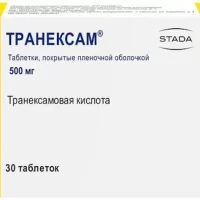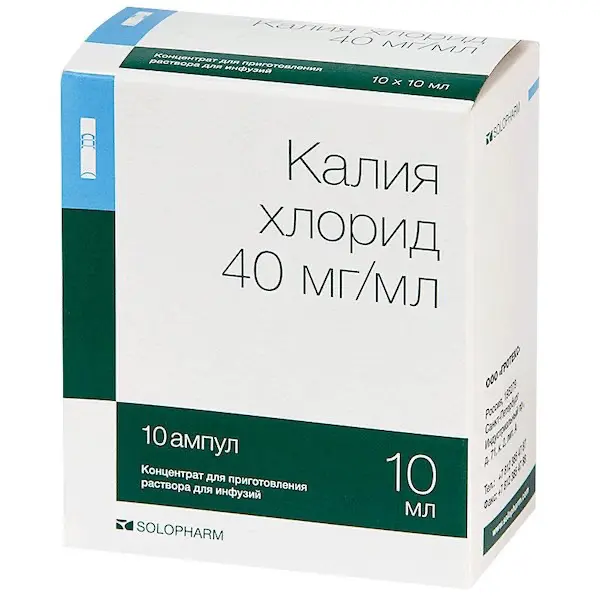Description
Tranexamic Acid-Trivium Pharmacodynamics
Antifibrinolytic agent, is a competitive (at high concentrations – non-competitive) inhibitor of plasminogen activation and its conversion into plasmin protease. It has local and systemic hemostatic action in bleeding associated with increased fibrinolysis (platelet pathology, menorrhagia). Also tranexamic acid by inhibiting the formation of kinins and other active peptides involved in allergic and inflammatory reactions has anti-allergic and anti-inflammatory effects. Experimental studies have confirmed the intrinsic analgesic activity of tranexamic acid, as well as its potentiating effect against the analgesic activity of opioid analgesics.
Tranexamic acid at a concentration of 1 mg/ml does not aggregate platelets in vitro, and at concentrations up to 10 mg/ml has no effect on platelet count, clotting time or various clotting factors in whole blood or citrate blood in a healthy person. On the other hand, tranexamic acid both at a concentration of 1 mg/ml blood and 10 mg/ml blood prolongs the thrombin time.
Indications
Prevention and treatment of bleeding due to generalized or localized fibrinolysis in adults and children 1 year and older.
Tranexamic acid preparations are used in the following situations:
– Treatment of bleeding due to generalized or localized fibrinolysis, such as: menorrhagia and metrorrhagia; gastrointestinal bleeding; and bleeding after prostate and bladder surgery;
– Prevention and treatment of bleeding during surgical interventions in the nose, mouth and pharynx (adenoidectomy, tonsillectomy, tooth extraction); during thoracic, abdominal and other major surgical interventions (including cardiac surgery); during gynecological surgical interventions;
– Treatment of obstetric and gynecologic bleedings;
– Treatment of bleeding caused by the use of fibrinolytic drugs.
Contraindications
Hypersensitivity to tranexamic acid.
Severe chronic renal failure (glomerular filtration rate [GFR] less than 30 mg/mL/1.73m2) due to the risk of cumulation.
Venous or arterial thrombosis at present or in the anamnesis (deep vein thrombosis of the legs, pulmonary embolism, intracranial thrombosis, etc.) when simultaneous anticoagulant therapy is impossible.
Fibrinolysis due to consumption coagulopathy (hypocoagulable stage of disseminated intravascular coagulation syndrome [DIC]).
A history of seizures.
Acquired color vision disorder.
Subarachnoid hemorrhage (due to the risk of cerebral edema, ischemia and cerebral infarction).
Treatment of menorrhagia in patients under 16 years of age (no experience of use).
Under 1 year of age (no experience).
Dosage and administration method
- Intravenously by drip or stream slowly; infusion rate 1 ml/min (50 mg/min). Rapid intravenous administration should be avoided!
- Adult patients:
- – Treatment of menorrhagia and metrorrhagia, gastrointestinal bleeding: 500 mg (2 ampoules 5 ml) 2-3 times a day from the time of bleeding until it stops;
- – Treatment of bleeding after surgical interventions on the prostate and the bladder: 1000 mg (4 ampoules, 5 ml) 3 times a day from the moment of bleeding until it stops;
- – Treatment of bleeding caused by generalized fibrinolysis: 15 mg/kg of body weight every 6-8 hours from the development of bleeding until its stopping;
- – Treatment of bleeding caused by local fibrinolysis: 500 mg (2 ampoules, 5 ml) 2-3 times a day from the moment of bleeding development until its stopping;
- – Prophylaxis and treatment of bleeding:
- – During surgical interventions in the nose, mouth and pharynx: 10-15 mg/kg body weight every 6-8 hours until bleeding stops;
- – In thoracic, abdominal and other major surgical interventions:
- 15 mg/kg body weight every 6-8 hours until bleeding stops;
- – during cardiac surgery: a loading dose of 15 mg/kg after induction of anesthesia prior to surgery, followed by intravenous infusion at a rate of 4.5 mg/kg/hour during the entire operation; tranexamic acid at a dose of 0.6 mg/kg in a machine for artificial circulation is recommended;
- – for gynecological surgical interventions: 10-15 mg/kg body weight every 6-8 hours until bleeding stops;
- – Treatment of obstetric and gynecological bleeding: 15 mg/kg body weight every 6-8 hours from the time of bleeding until bleeding stops;
- – Treatment of bleeding caused by the use of fibrinolytic drugs: 10 mg/kg of body weight every 6-8 hours from the development of bleeding until the bleeding stops.
- In case of necessity of prolonged (more than 48 hours) hemostatic therapy it is recommended to use tranexamic acid preparations in tablet dosage form.
- Children over 1 year of age:
- There is limited experience with tranexamic acid preparations in children. Recommended drug dose for treatment of bleeding caused by local and generalized fibrinolysis is 20 mg/kg/day.
- Administration of the drug in special groups of patients:
- Renal dysfunction.
- In patients with mild to moderate renal excretory dysfunction it is necessary to correct the dose and the administration rate of tranexamic acid:
- Serum creatinine concentration Glomerular filtration rate
- Filterration rate (GFR) Tranexamic acid Dose
- 120-249 μmol/L
- (1.36-2.82 mg/dL) 60-89 mL/min/1.73m2 15 mg/kg body weight 2 times daily
- 250-500 μmol/L
- (2.83-5.66 mg/dL) 30-59 mL/min/1.73m2 15 mg/kg body weight 1 time daily
- Impaired liver function
- No dose adjustment is required in patients with hepatic impairment.
- Elderly age.
- No dose adjustment is required in elderly patients in the absence of renal impairment.





